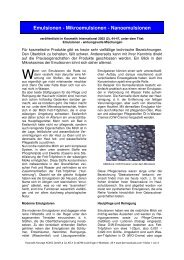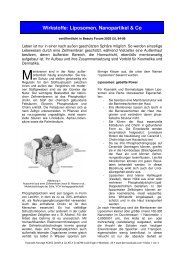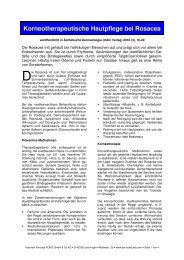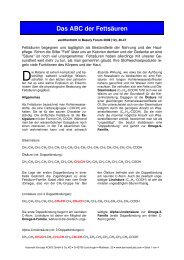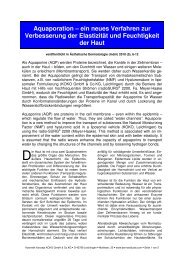Actinic keratoses - an endemic disease - Dermaviduals
Actinic keratoses - an endemic disease - Dermaviduals
Actinic keratoses - an endemic disease - Dermaviduals
Create successful ePaper yourself
Turn your PDF publications into a flip-book with our unique Google optimized e-Paper software.
<strong>Actinic</strong> <strong>keratoses</strong> - <strong>an</strong> <strong>endemic</strong> <strong>disease</strong>? page 2 of 2<br />
contains essential oils <strong>an</strong>d saccharides such<br />
as galactose, arabinose, m<strong>an</strong>nose <strong>an</strong>d xylose.<br />
According to the current state of knowledge,<br />
the boswellic acids are the pharmacological<br />
effective agents among the components of the<br />
above mentioned olib<strong>an</strong>um resins. Sashwati et<br />
al. (cf DNA <strong>an</strong>d Cell Biology 24 (4), 244-255,<br />
2005) detected the <strong>an</strong>ti-inflammatory <strong>an</strong>d<br />
collagen protecting mech<strong>an</strong>ism of the boswellic<br />
acid. Furthermore, a signal cascade was<br />
identified where acetyl-keto-boswellic acid<br />
inhibits the expression of matrix metalloproteinases<br />
(MMP), i.e. enzymes which selectively<br />
destroy peptid bonds <strong>an</strong>d structural proteins<br />
like collagen <strong>an</strong>d connective tissue.<br />
Acetyl-keto-boswellic acid signific<strong>an</strong>tly inhibits<br />
the expression of VCAM <strong>an</strong>d ICAM, the adhesion<br />
molecules which participate in infiltrating<br />
white blood cells into the inflamed area.<br />
The org<strong>an</strong>ism copes with tissue damages by<br />
provoking inflammatory reactions as a me<strong>an</strong>s<br />
to remove the damaging foreign bodies or the<br />
damaged tissue parts <strong>an</strong>d to replace them by<br />
repair tissue. Hence, inflammations are<br />
physiological processes. There are however<br />
situations where inflammatory processes may<br />
considerably damage org<strong>an</strong> functions, <strong>an</strong>d in<br />
this specific case, the skin functions. Inflammations<br />
are biochemically started by the<br />
release of so-called inflammation mediators.<br />
There are two types of different inflammation<br />
mediators which are involved in initiating <strong>an</strong>d<br />
maintaining inflammatory processes, viz.<br />
prostagl<strong>an</strong>dins <strong>an</strong>d leukotrienes. The current<br />
therapy of inflammatory processes consists of<br />
medicinal drugs which are able to block the socalled<br />
arachidonic acid cascade, i.e. the<br />
specific part which contributes to the formation<br />
of prostagl<strong>an</strong>dins. The drugs used are part of<br />
the steroid <strong>an</strong>d non-steroid <strong>an</strong>tiphlogistics.<br />
Based on this mech<strong>an</strong>ism also is the use of<br />
Diclofenac for the treatment of actinic keratosis.<br />
The <strong>an</strong>ti-inflammatory effect of the boswellic<br />
acids was repeatedly published (Safayhi, H., et<br />
al., Pl<strong>an</strong>ta Medica 63, 487-493, 1997, J.<br />
Pharmacol <strong>an</strong>d Exp. Ther., 261, 1163-46,<br />
1992). By screening the hum<strong>an</strong> genome,<br />
Sashwati et al. <strong>an</strong>alysed the genetic base of<br />
the <strong>an</strong>tiphlogistic effect of boswellia in<br />
microvascular endothelial cells <strong>an</strong>d discovered<br />
that it inhibits the 5-lipoxygenase, which is a<br />
key enzyme for the biosynthesis of<br />
leukotrienes. The studies showed that 3-Oacetyl-11-keto-ß-boswellic<br />
acid proved to be<br />
the most effective 5-lipoxygenase inhibitor<br />
among the different boswellic acids.<br />
Furthermore, the boswellic acids prevented the<br />
TNF-alpha-induced expression of metalloproteinases<br />
<strong>an</strong>d of apoptosis mediators.<br />
Boswellia extracts also prevented the<br />
expression of VCAM-1 <strong>an</strong>d ICAM-1. The<br />
results of these studies showed that the <strong>an</strong>tiinflammatory<br />
effects of boswellia extracts<br />
consisted in influencing the signalling<br />
mech<strong>an</strong>ism of the inflammation. Additionally,<br />
boswellic acids have cytostatic effects which<br />
are based on the inhibition of topoisomerases<br />
as reported in Syrovets et al., Mol. Pharmacol,<br />
58, 71-81, 2000. It could also be demonstrated<br />
that boswellic acids spark off apoptoses (cf<br />
Shao et al., Pl<strong>an</strong>ta Medica 64, 328-331, 1998).<br />
The effects mentioned suggest boswellic acids<br />
as <strong>an</strong> appropriate drug for the treatment of<br />
tumors as Ammon <strong>an</strong>d Simmet have shown<br />
with their therapy of brain tumors. Only<br />
recently there have been reports on the<br />
chemopreventive <strong>an</strong>d therapeutic effects of<br />
acetyl-keto-boswellic acids in the treatment of<br />
different types of c<strong>an</strong>cer (cf Glaser T, et al., Br<br />
J C<strong>an</strong>cer 80: 756-765, 1999; J<strong>an</strong>ssen G et al.,<br />
Klin Pädiatr 212: 189-195, 2000; Winking M et<br />
al.: J Neurooncol 46: 97-103, 2000). In this<br />
connection, the boswellic acid-induced<br />
inhibition of the topoisomerase-1 <strong>an</strong>d -2 <strong>an</strong>d of<br />
the caspase-8 seems to play a signific<strong>an</strong>t role<br />
(cf Ji<strong>an</strong>-Jun Liu et al., Intern J of Molecular<br />
Medicine 10: 501-505, 2002).<br />
According to the current state of knowledge,<br />
the treatment of inflammatory <strong>an</strong>d malign<strong>an</strong>t<br />
skin <strong>disease</strong>s with boswellia extracts or with<br />
isolated boswellic acids <strong>an</strong>d their derivatives<br />
has not yet been mentioned in the international<br />
scientific literature.<br />
For the treatment of actinic <strong>keratoses</strong>, a<br />
st<strong>an</strong>dardised boswellia extract containing at<br />
least 30 percent of acetyl-keto-boswellic acid<br />
has been isolated <strong>an</strong>d embedded in<br />
n<strong>an</strong>oparticles. This active concentrate has<br />
been very well tolerated on the skin, it is nongreasing<br />
<strong>an</strong>d free of the excessively adhesive<br />
properties of the raw extract. The boswellia<br />
concentrate was blended into a DMS cream<br />
(Derma Membr<strong>an</strong>e Structure), (KOKO, Leichlingen)<br />
<strong>an</strong>d used for the treatment of actinic<br />
<strong>keratoses</strong> <strong>an</strong>d psoriasis lesions. Additionally,<br />
the boswellia extract was added to a vegetable<br />
oil mixture <strong>an</strong>d used as a pack for the<br />
treatment of the scalp.<br />
First pilot applications have proved that<br />
inflammatory <strong>an</strong>d proliferative skin <strong>disease</strong>s<br />
healed relatively fast with the above mentioned<br />
therapy. These primary results seem to<br />
present boswellia extracts as a promising<br />
therapy against inflammatory <strong>an</strong>d malign<strong>an</strong>t<br />
skin <strong>disease</strong>s. Further field studies regarding<br />
psoriasis <strong>an</strong>d spinocellular carcinoma cases<br />
but also inflammatory skin <strong>disease</strong>s like<br />
neurodermatitis <strong>an</strong>d acne have been<br />
scheduled.<br />
Dr. H. Jabs<br />
Kosmetik Konzept KOKO GmbH & Co.KG • D-42799 Leichlingen • Moltkestr. 25 • www.dermaviduals.com • page 2 of 2



